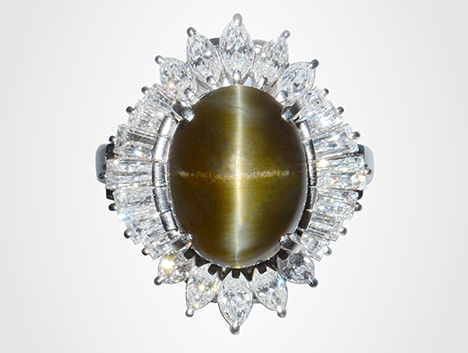Four-Rayed Star Chrysoberyl

GIA’s Tokyo laboratory recently received a brownish green cabochon set in a white metal ring with numerous near-colorless marquise brilliants and tapered baguettes (figure 1). The stone measured approximately 12.21 × 9.20 × 8.17 mm. Standard gemological testing showed weak green and yellow pleochroism and a spot refractive index reading of 1.75, as well as a strong diagnostic iron-related 444 nm band observed with a handheld spectroscope. These properties were consistent with chrysoberyl. At first glance the cabochon seemed to display chatoyancy, which would make this a cat’s-eye chrysoberyl. However, there was not just a single band of reflected light but two bands intersecting at a 90° angle, so the phenomenon was actually four-rayed asterism.

Chatoyancy is usually created by light reflecting off of parallel needles or tube-like inclusions in a cabochon-cut gemstone. Microscopic observation revealed two sets of inclusions. One consisted of dense minute particles aligned in one direction producing a thick band of reflected light (oriented diagonally in figure 2). The other set was composed of needles oriented along the same direction as the thick band of light. These needles created a second band of reflected light perpendicular to the orientation of the needles. Together, these reflected bands of light resulted in the unique combination of two intersecting cat’s-eyes.
Four-rayed stars are common in diopside, garnet, and spinel. But they are very rare in chrysoberyl, which makes this stone notable.



